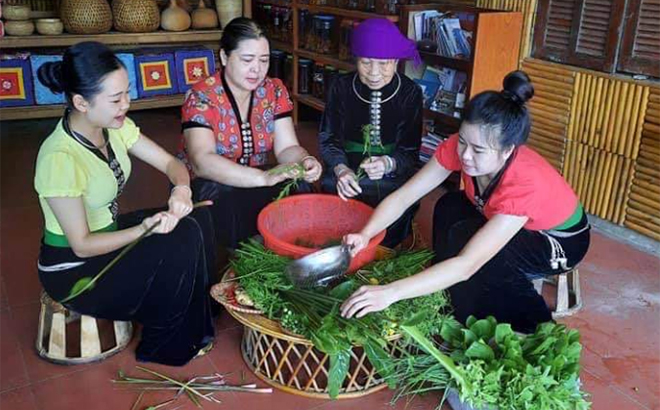Yen Bai preserves cuisine of Thai ethnic group
- Friday, February 17, 2023
Traditional food, especially the dishes of Thai ethnic people, is a special cultural identity of Nghia Lo - Muong Lo area. Here, in each family of Thai people, that cultural identity has been passed down from generation to generation.

|
|
An elderly woman in Nghia An commune of Nghia Lo township teaches her descendants how to cook traditional dishes.
|
The family of Luong Van Moc and Chu Thi Duong in Deu 1 hamlet of Nghia An commune has long been known for making Thai ethnic food. Duong has taught cooking secrets of every dish, from pa pinh top, phac pham, dried meat, sausage to five-coloured steamed sticky rice and salad, to her children.
She said spices form a very important part of her ethnic group’s cuisine, and people need rich experience to cook delicious dishes that are like no other.
Her daughter, Luong Thi Thuy Huong, noted she watched her parents cook dishes and tasted the foods since she was small, so the particular flavor of each dish is now deep in her mind. When Huong grew up, she was taught how to cook them, especially how to prepare spices and aromatise food. Thanks to that, she can now cook as well as her mother does.
Meanwhile, after repeated failures in making smoked meat, Luong Thi Hoan, a resident in Deu 2 hamlet of Nghia An commune, has reaped an initial success in producing and selling smoked meat branded "Ba Chay”. To create a product meeting her standards, it has taken her a lot of patience and experience gained day by day.
Smoking beef and pork needs to ensure that meat slices are dry on the texture but soft, dark red, aromatic, and sweet inside. In particular, smoked pork belly must also be dry on the outside and soft and light yellow inside with a distinctive flavor maintained, making it suitable for roast or stir-fry dishes. Smoked meat requires careful touches, from the thickness of slices to the flavor, spices, and temperature, Hoan added.
Traditional dishes of ethnic groups have been not only maintained in each family and the daily life but also optimised for tourism development. Apart from opening cooking classes for households engaging in community-based tourism, authorities of Nghia Lo township have also frequently held contests and fairs on the occasion of big festivals and anniversaries to give visitors chances to try making and taste traditional foods.
Dinh Anh Tuan, head of the township’s culture and information division, said that the division has proposed the Nghia Lo People’s Committee hold various activities each year to maintain and teach the making of traditional foods. It has coordinated with relevant sides such as schools to teach how to cook those dishes to students during extracurricular activities. Meanwhile, economic authorities have worked to develop products under the One Commune, One Product (OCOP) programme to popularise traditional cuisine.
Nghia Lo township has also made its name known as it had the biggest tray of five-coloured steamed sticky rice in the country recognised by the Vietnam Book of Records, and is home to many OCOP products which are traditional dishes such as smoked meat and sausage.
The special flavours of natural spices, meticulous recipes, and local residents’ love for the traditional foods are important factors contributing to the culinary culture of Thai ethnic people in the Nghia Lo - Muong Lo area.
Thu Hanh